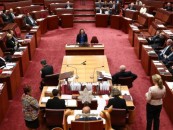ELECTRICITY bills are a huge worry for many Australians. In coming months a lot of people will receive the biggest household utility bills they have ever seen.
The latest figures from the ABS show that in the five years to June 2012, Australia’s retail electricity prices rose by 72 per cent with even higher increases in Melbourne and Sydney.
The Queensland Competition Authority’s annual report revealed recently that 344 households were disconnected every week in the Sunshine state due to non-payment of electricity bills.
Senators and Members, however, don’t need to worry about whether staying warm in chilly Canberra might send them broke. Perhaps if they had to pay for their own heating and air conditioning in Parliament House, it would concentrate their minds on the very important discussion we need to have on the future of the Renewable Energy Target
The repeal of the carbon tax will help, but studies show that the Renewable Energy Target has an even greater impact on the bottom line, reducing our living standards and the competitiveness of our entire economy.
The dramatic surge in power bills has been a major factor in the decline of our manufacturing sector and the loss of thousands of jobs. In little more than ten years the RET has rocketed Australia from almost the cheapest to almost the most expensive electricity in the world: Australian states occupy four of the top six spots only beaten by Denmark and Germany. These countries are also sapped pointlessly with punishing renewable energy policies producing small amounts of extremely expensive, intermittent power that has to be backed up by fossil fuel power anyway.
Contrary to claims by industry lobby groups mostly representing Big Wind producers, merchant bankers and consultants, it is no coincidence that power prices went up so steeply when mandatory renewable energy targets were introduced.
A report from the accounting firm Deloitte showed that the RET will stifle the economy, cost jobs and drive up prices, and is a very inefficient means of reducing greenhouse gas emissions. It concludes that abolishing the RET would increase real GDP by $29 billion in net present terms relative to the RET continuation.
The chief beneficiary of the RET is the wind industry, which receives Renewable Energy Certificates currently worth about $30 for every megawatt of electricity it produces, on top of the price paid to them for electricity generated by wind turbines. The certificates are funded by electricity customers as a hidden charge on their bills.
The net effect of this subsidy is to hand an additional $17 billion of
our money to these companies over 15 years for no measurable environmental benefit.
It is undisputed that despite being a mature technology the wind generation industry is not viable anywhere in the world withoutgovernment or customer subsidies. It is just government mandated corporate welfare.
Grant King, CEO of Origin Energy, one of Australia’s largest electricity retailers with extensive interests in gas as well as wind energy generation said last year that the RET will be the main driver of electricity price rises by 2020. He also said that renewable energy costs now accounted for 14 per cent of electricity bills, up from 2 per cent five years ago. For larger users it accounted for 30 per cent of their bills.
If Labor, the Greens and Clive Palmer really care for social justice they will not allow working families, pensioners and the disadvantaged to be ripped off by wealthy wind generators anymore and they will back abolition of the RET.








